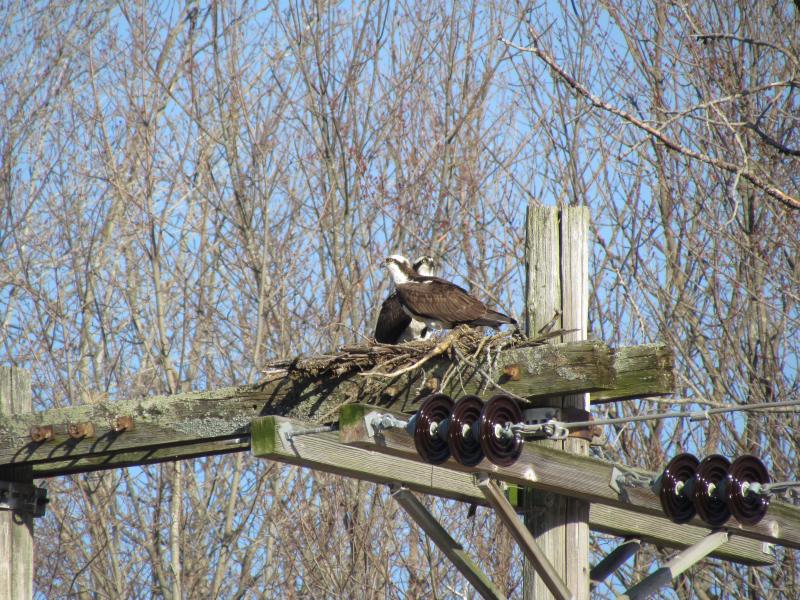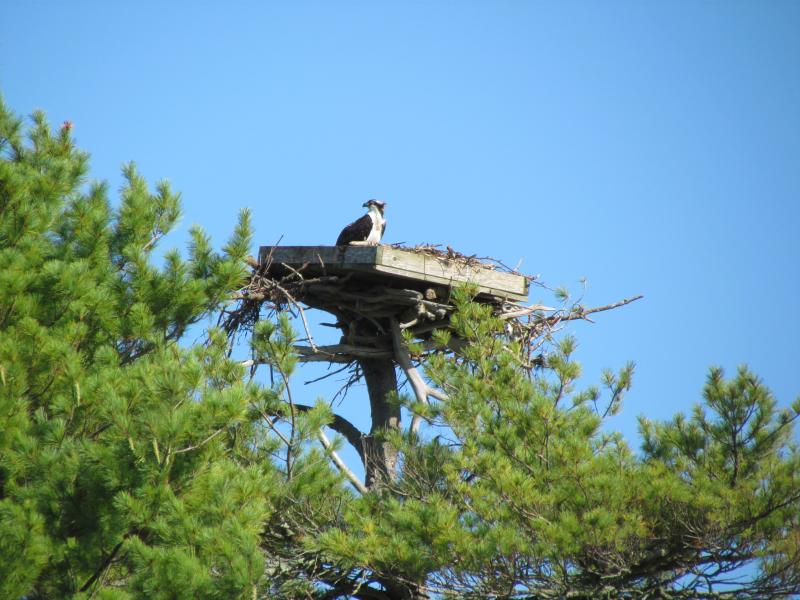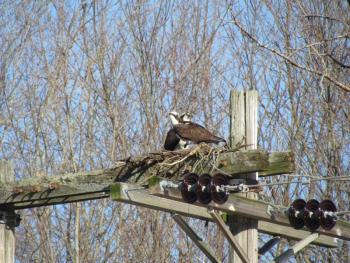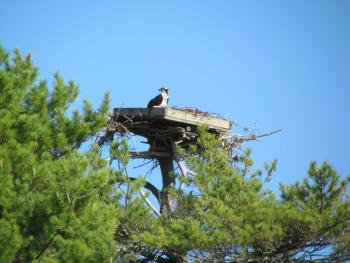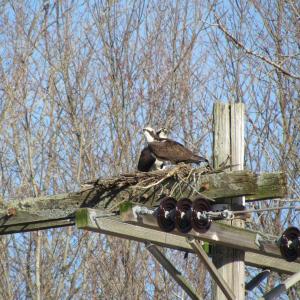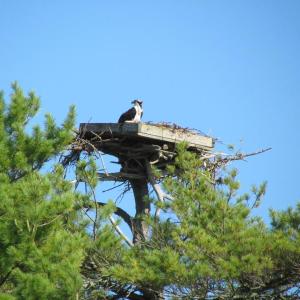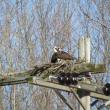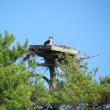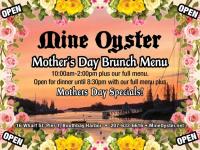The Persistence of Ospreys
Mistakes happen. Even in the bird world. Take for example the osprey that recently tried repeatedly to place sticks atop a tall light pole, high above the Bates College athletic field in Lewiston. The sticks kept falling off and landing in the field, apparently because there was not enough of a platform for them to stay in place. We have probably all seen osprey nests on light poles at school athletic fields and on the cross bars of large utility poles throughout the state. Such places often work just fine to place a nest. This bird, though, couldn’t make it work. Was he (we presume it was a male since males usually do most of the work to carry sticks to a nest site but we may be wrong) bad at choosing a site, or was he a poor or inexperienced nest builder?
Perhaps the bird was in its first year and hoped it could build an attractive nest that would entice a female to mate with him. There were several things that fit the bill for what ospreys like. The hoped-for nest site was very high, which would have presumably provided some protection for chicks from great horned owls and bald eagles looking for an easy snack. Both of those species are known to take osprey chicks from nests. At the very least, it would have provided great visibility to spot any avian predators coming from a distance.
The site was also beside a small pond on the college campus that might provide some easy fishing, although we suspect that the fish population in such a small pond might not have provided enough to sustain a pair of osprey and chicks all summer. Still, the Androscoggin River is only half a mile away—an easy commute to a feeding ground for an osprey.
It will be interesting to hear whether or not this bird finds another, better spot nearby and eventually does construct a nest somewhere on the Bates College campus. Ospreys are famous for being persistent in their nest-building and their reconstruction of damaged nests. We were told of and heard many reports of osprey nests that were removed this winter from traditional spots on power lines. Nests that are highly visible are a topic of spring conversation even among people who don’t consider themselves “birders”: “The ospreys are back at (insert name of place here)!” These osprey fans watch and report on the progress as the birds repair the nest, sit on eggs laid in the nest, bring food to the young nestled down in the nest, rejoice when they appear on the edge of the nest, and mark the day when the ospreys are no longer there, presumably headed south for the winter.
It’s a bad PR move for companies who remove those nests, and it’s also a fruitless one. Said company will be spoken of with disdain on social media and elsewhere. And, inevitably, the osprey pair will rebuild the nest in or near the same spot, to the delight of their human “guardians.” Utility companies where we lived for a while in upstate New York put platforms above the crossbars on utility poles so the birds would nest there rather than on the crossbars themselves.
Some ospreys will build a new nest in late summer before they depart for the wintering grounds. Are these individuals practicing for next year? Are they building an extra nest in case their primary nest doesn’t last the winter or gets taken over by another osprey—or even by a great horned owl, as happened to our brother and sister-in-law’s favorite osprey nest, which we wrote about in a past column.
Osprey nests are large and obvious so there are lots of interesting stories out there about odd and unusual nesting sites and nesting attempts. They are not alone in their strange choices. We’ve seen mourning dove nests on the ground, on air conditioners, and on ledges of houses; house finch nests in dried-out Christmas wreaths still hanging on front doors. Mother Jewell (Allison’s mom) hosted a Carolina wren in the clothespin bag that was hanging off her clothesline—Jewell made this discovery upon reaching into the bag, only to have the wren come flashing out! We’ve even heard of barn swallow nests on active ferries! We’ll save more of those stories for another column, but feel free to share your stories of odd and unusual bird nesting locations!
Jeffrey V. Wells, Ph.D., is a Fellow of the Cornell Lab of Ornithology and Vice President of Boreal Conservation for National Audubon. Dr. Wells is one of the nation's leading bird experts and conservation biologists. He is a coauthor of the seminal “Birds of Maine” book and author of the “Birder’s Conservation Handbook.” His grandfather, the late John Chase, was a columnist for the Boothbay Register for many years. Allison Childs Wells, formerly of the Cornell Lab of Ornithology, is a senior director at the Natural Resources Council of Maine, a nonprofit membership organization working statewide to protect the nature of Maine. Both are widely published natural history writers and are the authors of the popular books, “Maine’s Favorite Birds” (Tilbury House) and “Birds of Aruba, Bonaire, and Curaçao: A Site and Field Guide,” (Cornell University Press).

